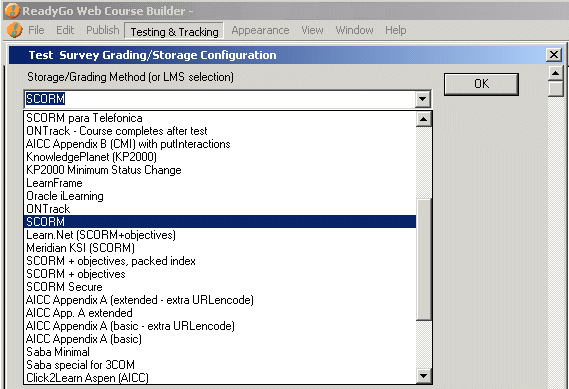 Back
Back| 5.2.1 5.2a What are all the options for LMS/Storage Method within ReadyGo? |
ReadyGo contains a long list of Storage Methods/LMS names. What is each one of them?This list refers primarily to the way test scores are transmitted to the server. In terms of Course Structure Files (AICC) or XML Manifest files (SCORM), ReadyGo produces the files automatically. For AICC, CSFs with Level 3B are produced. (Note that most LMSs only use the Level 1 features of the AICC CSFs.)

- No Storage - Tests Graded by Browser: This is the default for ReadyGo courses. There is no reporting of grades to a central server. The course can be served entirely from a CD-ROM, hard-disk, etc.
- ReadyGo Server Side Testing: ReadyGo has developed a very inexpensive student registration and assessment collection engine. Server Side Testing can be hosted on any standard web server. It does all collection on a per-course basis. Results are stored as ASCII comma-separated variable lists so you can load them into your database easily. Server Side Testing does not conform to AICC or SCORM standards, but it does collect all student results, and it can generate test questions in randomized order.
- SCORM: The basic SCORM implementation of a ReadyGo course fills in only the[CORE] set of data. This includes a test score for each SCO/unit and completion status.
- SCORM + objectives (packed index): This version does everything in the basic SCORM version, but it also stores an interaction and an objective for each test question as it is answered. The "packed index" means that as each test is graded, the new submissions are appended to existing ones. So if you have a test with 3 questions, each time the student answers the same test questions, the number of interactions and objectives in increased by 3. Results are ordered based on the submission order. Each test/survey question becomes an objective and an interaction. Both SCORM+objectives methods report pass/fail scores for each test question in addition to what the student actually submitted as a response.
- SCORM+objectives: This implementation stores the interactions based on their location in the course, regardless of when the student submits the responses. So, for example, if you have 2 tests in your unit, each of which has 3 questions, all submissions related to the first question on the second test will be stored at index 3. The submissions for the first test will always be stored at locations 0, 1, and 2. Each test question is considered one interaction.
- AICC Appendix A (Basic): Uses the HACP communication method for AICC. This only stores the [core] set of data using putParam. Most LMSs only use the [core] set. Data is URL encoded prior to transmission to the LMS.
- AICC Appendix B (CMI) with putInteractions: Stores the [core] set using the API function putParam(). It also stores interactions using putInteractions(). This approach is what has become SCORM. Each interaction retains its storage index.
- Knowledge Planet KP2000: AICC Appendix A basic with URL encoded data transmitted to the LMS. At startup, this approach requires a "relay" servlet that translates the LMS response from "plain/text" into JavaScript variables that the browser can interpret. When the student reaches the end of the course, the course is reported as completed.
- KP2000 Minimum Status Change: Same as Knowledge Planet KP2000, but course completion status is left as incomplete so that it can be set through another system.
- LearnFrame: AICC Appendix A basic, data is URL encoded prior to transmission to the LMS.
- Meridian KSI (SCORM): SCORM + objectives.
- Oracle iLearning:For use with Oracle's iLearning LMS. ReadyGo is the only tool currently integrated with their system. It uses a combination of AICC Appendix B (CMI/API) for course communication and a customized IMS 1.1 for course structure file information.
- AICC Appendix A (Extended): Uses HACP for course-to-LMS communication. This version also includes putInteractions to report scores for individual test questions.
- GeoMetrix Training Partner 2000: AICC Appendix A basic. Responses are URL encoded prior to transmission to the server,
- Question Mark Perception: This approach creates links from the "Test/Survey"button in the ReadyGo course to the specified setup for QuestionMark's server-based assessment engine. Test questions are build in QuestionMark. (Low priced option)
- Avilar (LMS RTE Level 3 SCORM Certified):SCORM + objectives (packed index). Scores are normalized to between 0 an 100.
- ThinQ Training Server LMS: AICC Appendix A basic. Answers are URL encoded prior to transmission.
- Docent: AICC Appendix A basic. Answers are not URL encoded prior to transmission.
- Saba: AICC Appendix A basic. Answers are not URL encoded prior to transmission. Submittal must have all non-AICC form variables before AICC_DATA.
- GeoLearning AICC Appendix A basic, no URL encoding. Because GeoLearning uses Cold Fusion students who have the ColdFusion software installed on their computer may have trouble viewing courses. Also, the course URL, that contains routing information needs to be URL-decoded multiple times because Windows XP re-encodes it.
- LearnerWeb SCORM. This is an inexpensive LMS produced by MaxIT
- Isoph Blue AICC Appendix A basic, no URL encoding